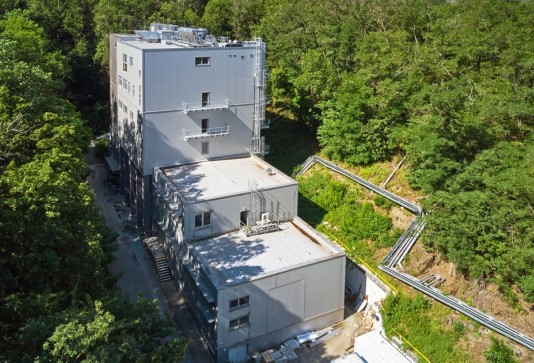
About the project
Ultra-trace isotope research in social and environmental studies using accelerator mass spectrometry
 Establishment of the first AMS laboratory in the Czech Republic – Extension of the CANAM infrastructure in reconstructed building of the former Van de Graaff accelerator on the premises of NPI of the CAS in Řež
Establishment of the first AMS laboratory in the Czech Republic – Extension of the CANAM infrastructure in reconstructed building of the former Van de Graaff accelerator on the premises of NPI of the CAS in Řež
Beneficiary of the project: NPI of the CAS, p. r. i.
Partners of the project:
Institute of Archaeology of the CAS, Prague, p. r. i.
Faculty of Nuclear Sciences and Physical Engineering,
CTU in Prague (Department of Nuclear Chemistry)
Accelerator Mass Spectrometry (AMS), the most powerful technique for determination of ultra-trace levels of isotopes (with detection limits of up to 6 orders of magnitude lower compared to decay counting), is still missing in the Czech Republic, although it provides means for excellent research in a variety of scientific and technological disciplines. Thus, data on ultra-trace levels of isotopes can only be obtained in a limited extent in AMS laboratories abroad. To overcome this gap a new AMS laboratory will be established to extend the large research infrastructure of Centre of Accelerator and Nuclear Analytical Methods (CANAM) at NPI under the RAMSES project. The new infrastructure will concentrate on research using 14C, actinide research and cosmogenic radionuclides. In 14C research, it will make possible to achieve the following objectives: determination of 14C for radiocarbon dating in archaeology, climatology and palaeoecology up to 50 thousand years ago, measurement of 14C emissions in the vicinity of nuclear power plants, verification of the fossil/recent carbon content in motor fuels, combustion products, food, pharmaceutics and cosmetic materials. The areas of interest for actinide research are mostly related to the sources of actinides and their behaviour in the environment, screening and monitoring of anthropogenic activities, mainly in nuclear fission fuel cycle, production and testing of nuclear weapons, and illicit trafficking of nuclear materials (Safeguard analyses). Determination of cosmogenic radionuclides 10Be and 26Al will be used as radiometric clocks to establish an absolute time scale for the environmental events of the earlier Quaternary period in biology, climatology, geography and geology, providing knowledge needed for reconstruction of past environmental conditions on the global scale, establishing the rates and types of local- and large-scale processes such as erosion and accumulation, soil development and landscape evolution. These two isotopes are also unique tools for determining of age of meteorites.
Thus, the objective of the project is to enable and perform multidisciplinary research, enlarge the research topics possible to investigate by the establishment of the new AMS laboratory, which will comprise a project for and reconstruction of a building at NPI premises in Řež to house a new, medium type, AMS accelerator (with terminal voltage of up to 1MV) and new laboratories. Next step will be acquiring of the existing procedures for sample (target) preparation for AMS determination of 14C, other cosmogenic radionuclides, namely 10Be and 26Al, and selected actinides. The procedures acquired and/or amended will be used for multidisciplinary applications as given above. In order to accomplish all the above goals, the AMS laboratory will cooperate with four renowned AMS laboratories abroad, which will serve as strategic partners of the project.
Project Nr. CZ.02.1.01/0.0/0.0/16_019/0000728: “RAMSES - Ultra-trace isotope research in social and environmental studies using accelerator mass spectrometry“ is funded by MEYS and European Union – European Structural and Investment Funds, Operational Programme Research, Development and Education.
Key activities:
- Support of research in the field of Determination of 14C and radiocarbon dating
- Support of research in the field of Determination of selected actinides and fission products
- Support of research in the field of Determination of cosmogenic radionuclides
- Extension and Upgrade of the Research Infrastructure
- Development of the Research Team
- International Cooperation and Internationalization
- Project Management
Scientific content:
Determination of long-lived radio-nuclides
- 14C, 10Be, 26Al, cosmogenic nuclides
- actinides and fission products
- at levels or in amounts up to 10-6 lower compared to decay counting methods
Applications of 14C measurement for:
- Radiocarbon dating in archaeology, paleoecologyand other disciplines
- Bomb peak dating for environmental protectionand forensic medicine
- Environmental and geological studies, detection of environmental changes
- 14C in the atmosphere and in the vicinity of nuclear power plants
- Atmospheric 14CO2 and 14C environmental levels (reference background values)
- Green vs. fossil carbon 14C in motor fuels (HVO), pharmaceuticals, foods and chemical industry
- Microdosing of pharmaceuticals labeled with 14C
Applications of 10Be and 26Al measurement for:
- Geochemistry and paleoclimatic change studies (sediments, rocks, glaciers, …)
- Age determination of meteorites and other extraterrestrial materials
- Determination of cosmogenic nuclides
Applications of actinide and fission product measurement for:
- Geochronology, environmental control and monitoring
- Natural fission and neutron reactions
- Nuclear forensics and Safeguards, undeclared nuclear activities, nuclear weapon explosions


